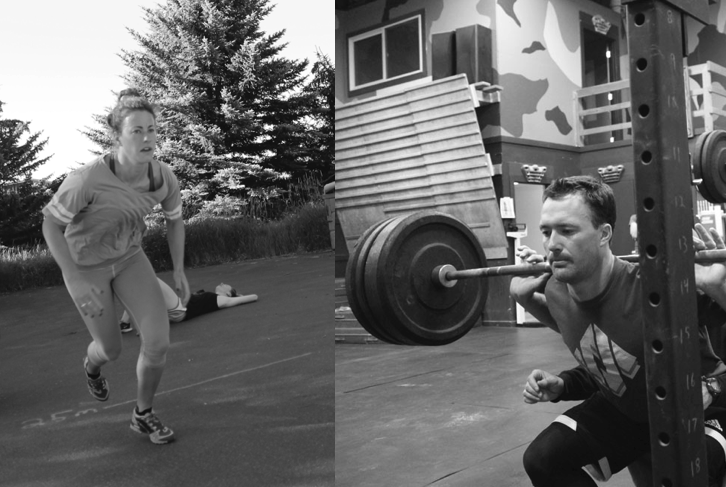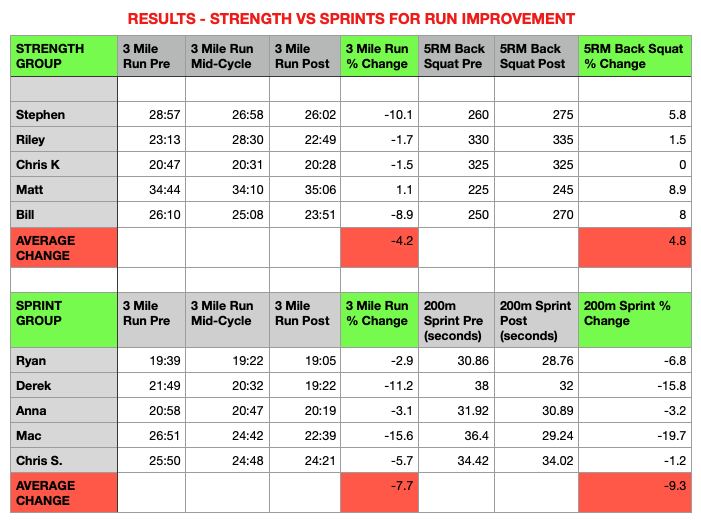
By Rob Shaul, Founder
BLUF
Short sprints of 50m, 100m and 200m out performed a strength progression of heavy lunges and back squats to improve 3-Mile Run times for remote, veteran, MTI athletes.
Background
Multiple scholarly studies have been conducted to research the impact of heavy resistance training on distance running.
Research has found that heavy resistance training improves distance running in several different ways:
- Running economy – or how efficiently used oxygen while running at a given pace (1)
- Reduced injury risk – by improving muscular strength and stability, thus reducing the risk of sprains and strains (2)
- Muscular endurance – ability of a muscle to perform repeated contractions without fatigue (3)
- Overall improved running performance – including maximal oxygen uptake, running economy and time to exhaustion at maximal aerobic speed (4)
- Increased lactate threshold- the point at which lactate production exceeds lactate clearance during exercise (5)
Research has also found that short sprints with full recovery can improve distance running performance in different ways:
- Greater power output (6)
- Running economy (7)
- Improved muscular power – the ability of a muscle to produce force quickly, which is important for sprinting and accelerating during distance running. (8)
More research has found that a combination of strength and sprint training can improve stride length and running form (9).
However, I was not able to find any study that compared resistance training vs. sprint training (with full recovery) and the impact of each on distance running performance. One study (10) compared resistance training to sprint interval training (anaerobic work capacity efforts) for distance running improvement and found that both significantly improved 10km run times, but that there were no significant differences between the groups.
For this study, I wanted to compare resistance strength training vs short sprint training (with full recovery) for 3-mile run improvement.
I was especially interested in the effects of short sprint training. Research has found that short sprint training, with full recovery, improves lower body strength, maximal isometric force, and peak power output during the counter movement jump. (11)
MTI programming does not currently deploy short sprint training, with full recovery, in our running programming. It does deploy strength training, but usually in the form of a leg blaster progression.
So why leg blasters instead of heavy back squats and lunges? Equipment issues …. our own research found that MTI’s leg blasters match heavy front squats in building lower body strength – even when the assessment in the mini study was a 1RM front squat. That’s right, leg blasters improve 1RM front squat improvement as much as heavy front squats!
So now you know why we use leg blasters so much in our programming – we’re able to get max effort strength improvement using bodyweight programming. This means athletes need less equipment and no lifting experience – which facilitates program completion.
So why didn’t I use leg blasters in this mini study – and chose heavy back squats and lunges instead?
From the classic perspective, leg blasters aren’t training max effort strength – rather they are training strength endurance (even though we’ve found they improve max effort strength). And for this initial study, I wanted to keep it classic, knowing we could study sprints vs. leg blasters in the future.
Study Design
Ten, veteran, MTI remote lab rats were divided into two groups – the Strength Group and the Sprint Group. Each completed a 3.5 week cycle, which began with a 3-Mile run assessment, in addition – for the sprint group, a 200m sprint assessment, and for the strength group, a 5RM Back Squat assessment.
Both groups completed the same running training, which included 1-mile interval repeats and 4-6 mile moderate-paced distance runs. Both groups also completed a mid-cycle, and end of cycle 3-mile run assessments.
The Strength Group trained heavy back squats and walking lunges on Tuesdays and Thursdays based loosely on MTI’s classic and proven Big 24 progression methodology.
The Sprint Group completed 50m, 100m and 200m sprint repeats, with full recovery between efforts, on Tuesdays and Thursdays.
At the end of 3 weeks, both groups re-assessed their 3-mile run times.
Below was the weekly schedule:
- Mon: 1-Mile Run Intervals
- Tue: Heavy Back Squats and Lunges (Strength Group); 50-200m Sprints (Sprint Group)
- Wed: 1-Mile Run Intervals
- Thu: Heavy Back Squats and Lunges (Strength Group); 50-200m Sprints (Sprint Group)
- Fri: 4-5 mile moderate paced run
Results & Discussion
See results below:

Based on this mini-study with fit, veteran athletes, sprint training (with full recovery), out performed heavy lower body resistance training to improve distance running performance, 7.7% improvement vs. 4.2%.
You’ll see also that the Sprint Group had a greater improvement in their 200m sprint time (9.3%) than the strength group did in their 5RM Back Squat (4.8%). However, this could be simply because we’ve never run short sprints like this with full recovery before – whereas heavy back squats are common for these lab rats.
Next Steps
The obvious next step is to compare short sprint training to a leg blaster progression for distance running improvement.
Comment below or send your questions/feedback to rob@mtntactical.com
References:
(1) Mikkola, J., Vesterinen, V., Taipale, R., Capostagno, B., Häkkinen, K., & Nummela, A. (2011). Effect of resistance training regimens on treadmill running and neuromuscular performance in recreational endurance runners. Journal of Strength and Conditioning Research, 25(3), 819-828.
(2) Lauersen, J. B., Bertelsen, D. M., & Andersen, L. B. (2014). The effectiveness of exercise interventions to prevent sports injuries: A systematic review and meta-analysis of randomised controlled trials. British Journal of Sports Medicine, 48(11), 871-877.
(3) Taipale, R. S., Mikkola, J., Salo, S. K., Hokka, L. T., & Nummela, A. T. (2010). Strength training in endurance runners. International Journal of Sports Medicine, 31(7), 468-476.
(4) Rønnestad, B. R., Hansen, J., & Ellefsen, S. (2012). Heavy strength training improves running and cycling performance following prolonged submaximal work in well-trained female athletes. Journal of Strength and Conditioning Research, 26(2), 427-435.
(5) Paavolainen, L., Hakkinen, K., Hamalainen, I., Nummela, A., & Rusko, H. (1999). Explosive-strength training improves 5-km running time by improving running economy and muscle power. Journal of Applied Physiology, 86(5), 1527-1533.
(6) Spurrs, R. W., Murphy, A. J., & Watsford, M. L. (2003). The effect of plyometric training on distance running performance. European Journal of Applied Physiology, 89(1), 1-7.
(7) Rønnestad, B. R., Hansen, E. A., & Raastad, T. (2012). In-season effects of short-sprint training on physical and physiological parameters of elite soccer players. Journal of Sports Sciences, 30(9), 901-908.
(8) Dalleau, G., Belli, A., Bourdin, M., & Lacour, J. R. (1998). The spring-mass model and the energy cost of treadmill running. European Journal of Applied Physiology and Occupational Physiology, 77(3), 257-263.
(9) Beattie, K., Carson, B. P., Lyons, M., & Kenny, I. C. (2017). The effect of strength training on performance indicators in distance runners. Journal of Sports Sciences, 35(8), 755-762.
(10) García-Pinillos, F., Roche-Seruendo, L. E., & Delgado-García, G. (2017). Effects of resistance training and sprint interval training on maximal anaerobic power and endurance performance in recreational endurance runners. Journal of Strength and Conditioning Research, 31(9), 2538-2545.
(11) Ebben, W. P., Feldmann, C. R., Dayne, A., Mitsche, D., & Alexander, P. (2009). Short-term recovery from power and speed training bouts influences vertical jump height and lower body kinematics. Journal of Strength and Conditioning Research, 23(9), 2577-2586.
